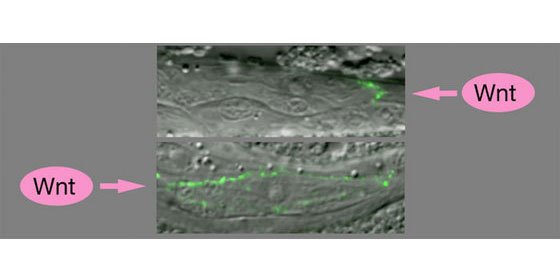Aug. 11, 2006 Research Highlight Biology Medicine / Disease
Off to one side: Determination of cell polarity by Wnt signaling
Cellular polarity is important in many forms of asymmetric cell division, the process by which a cell divides to produce daughter cells of different types.
 Figure 1: Wnt signaling in C. elegans
Figure 1: Wnt signaling in C. elegans
Cellular polarity is important in many forms of asymmetric cell division, the process by which a cell divides to produce daughter cells of different types. Communication between cells often dictates where, when and how cells become polarized and subsequently divide, but the means by which these molecular communiqués actually get the work done has remained obscure. The question of whether the Wnt signaling pathway functions as an essential positional cue in establishing cell polarity has been a particular teaser.
Now, in a study published in the March issue of the journal Developmental Cell, Hitoshi Sawa from RIKEN's Center for Developmental Biology in Kobe, and colleagues from Kobe University and at the University of North Carolina at Chapel Hill (USA) have revealed that Wnt signals can determine the polarity of both embryonic and postembryonic cells in the nematode C. elegans.
The collaborators looked first at the four-cell stage in nematode development, in which messages from one ‘signaling’ cell to its ‘responding’ neighbor result in the responder’s polarization, thereby enabling it to divide asymmetrically. Two factors expressed in the signaling cell, MOM-2 and MES-1, were known to play roles both in the mitotic spindle orientation and polarization of the EMS cell itself, and to send one of its daughters down the path to an endodermal fate, but it was not clear whether this was a result of MES-1 or the Wnt signal, MOM-2. To test these factors’ effects on development, the group placed the Wnt factor MOM-2 and the (non-Wnt) MES-1 cells in different positions relative to each other, and found that the orientation of the mitotic spindle, a cytoskeletal structure that pulls the chromosomes of a dividing cell apart, was consistently oriented in line with the source of the Wnt signal.
Wnt signaling is also known to play a role in the establishment of polarity in postembryonic cells, but here again, they faced the question of whether a Wnt factor (this time, LIN-44) serves in a permissive or an actively determinant capacity. In normal development, LIN-44 is usually expressed in cells posterior to the T cells found in the worm’s tail; the polarity of these cells is often reversed when this factor is absent. On misexpressing LIN-44 in cells anterior to T cells, the authors observed strong enhancement of the polarity reversal phenotype in lin-44 mutants. Once more, the position of the Wnt signal source was shown to play a critical role in determining cellular sidedness, this time at a postembryonic phase of development. The collaboration further showed that the Wnt signal determines the polarized localization of the Wnt receptor LIN-17/Frizzled in the T cell, indicating that its polarizing effect in these cells is direct.
References
- 1. Goldstein B, Takeshita H, Mizumoto K & Sawa H. Wnt signals can function as positional cues in establishing cell polarity. Developmental Cell 19, 391–396 (2006). doi: 10.1016/j.devcel.2005.12.016
